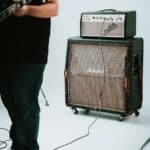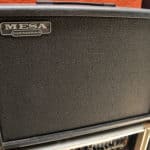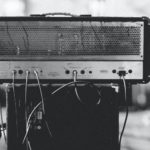When looking for an amplifier, as a guitar player you may think of a lot of options to build up your sound, within those choices you will find amp heads.
Although audiophile adept guitarists already know about this exceptional gear, we are here to spread the information to every existing musician, no matter if they are just starting or have played for long years.
In short, an amp head is a piece of equipment used in stack amps, they are in charge of the preamp section and the power stage. In general terms, amp heads do not produce any sound by themselves, they need to be connected to a speaker cabinet, however, some modern amp heads have speakers built-in.
For beginners, this could sound confusing and a hard task to do but with our help, you will learn what amp heads are plus most of their main functions.
Afterward, you will become an expert regarding this fascinating topic and could guide your guitarist friends when they have doubts about this issue.
What is an amp head actually?
An amp head is a particular gear, is not an amplifier as we know them but it includes the preamp section and the power stage as well.
Guitar amp heads are in charge of pre-amplifying and processing the signal before it goes to the speaker cabinets.
The interesting thing about amp heads is that they do not have speakers in them so they are unable to produce sound (some modern amp heads come with this feature included, though).
Therefore, to complete the entire chain, the output needs to be sent to a device that can translate the waves into actual sound, here is when the cabs take place and reproduce the processed signal.
In the same way that guitar amplifiers, amp heads come in different ways and sizes.
In the market, you will be able to find as many tube amp heads as solid-state ones.
Can you use an amp head as a stand-alone?
As a rule, amp heads require to be connected to any equipment that can produce sound, a cabinet, a speaker, or even a dummy load.
If you connect your precious gear but don’t match it properly, it will get really damaged, in some cases causing them to blow up.
This applies to both, valve and solid-state amp heads, being the first and the most prone to get ruined.
Nowadays is common to find more modern amp heads that have line-outs, or maybe preamp outs that bypass the power section, avoiding these terrible situations to happen.
To sum up, never use this kind of equipment as a stand-alone, only do it if you know that is safe to go for it.
However, the discussion does not finish here but as it is a truly wide topic to talk about, I will leave you a link to an article in which we cover every detail concerning this issue; if you are curious about amp heads used alone consider taking a look at it.
What is the difference between an amp head and a combo amp?
As mentioned before, amp heads are just the preamp and power sections, the head and the cabinet are two separate units so, to produce the output you require to match both.
Oppositely, some equipment provides the whole experience; preamp, power amp stage, and a speaker.
That kind of amplifier is known as a combo amp, they have the three stages included, the head and the amp are built in a single piece, so you only have to get one, plug in your guitar, and start to play.
Whereas combo amps could be more convenient because they come in a simple unit, an amp head plus cabinet speakers could give you more control to build and shape a desired or specific sound.
Is there a way of using an amp head without a speaker cabinet?
As a general rule, amp heads must be connected to the secondary winding, usually cabinets.
This is not just a capricious idea that comes to my mind, it is because the gear can be destroyed without secondary wiring.
Fortunately, there are some available options to avoid the use of cabs.
The first and more usual is using a dummy load, which is a device that tests the capability of the amp and also finds problems without the need for a high output.
As its name implies, it just simulates the load from a speaker so the amp can work normally.
Another alternative could be connecting your equipment to a mixer or a PA system.
Although you will not have the most faithful response without cabinets, it will be possible to run your amp head through them but only if your gear has a line out that bypasses the power section.
Of course, more options could be considered but they were already deeply discussed in the article previously referenced.
There you will find not only more choices but also a wider explanation, I encourage you to check it out!
Are amp heads recommended for beginners?
Although amp heads are better for modeling sound and finding the tone that suits more accurately to your playing style, I would rather recommend combo amps to beginners.
In the first place, head plus cabinets will be difficult to handle for inexperienced musicians, there are a lot of aspects to consider about each of the two components, and could be toughly overwhelming for a player who is giving his or her first steps with the instrument.
The reason I suggest using a combo amp for first learners is that they are simpler to manage, as they have every stage comprised in one single amplifier there are fewer things to worry about plus is easier to get used to it.
Besides, getting a head and its speaker cabinet will be hard to afford because they are more expensive than combo amps, even digital amps could work for starters and you could get them for a cheap price or even download them from the internet for free.
Do amp heads sound better?
In the world of music, there is no right or wrong nor better or worse, everything is personal, up to the player’s preferences.
That’s why I wouldn’t necessarily say that amp heads sound better.
This may be a common belief because the combination of an amp head and cabs is the form factor in which most high-end tube amps come in, as they are superior in quality most musicians tend to think they are better.
However, the interesting aspect of heads is not just their quality condition, is the flexibility that they provide.
This equipment allows you to mix and match it among different speaker cabinets that will give you a broad quantity of sonic options which is a great feature to further develop your desired tone.
In that way, you could connect your amp head to two distinct cabs and place them on opposite sides of the stage to create wonderfully panned sound atmospheres.
In addition, you could tour just with your amp head without the need of having your cabs with you too. You could, for instance, rent or also borrow a speaker cabinet for a gig.
What are the benefits of amp heads?
Amp heads are really amazing gears, they are truly useful and broadly used for experienced musicians.
That’s why I will list the most noticeable benefits of this wonderful piece of equipment.
- Modularity and versatility: amp heads are able to be separated and recombined with other cabinets.
- Transportability: as you can pair your head with many cabs, you won’t have to take the latter every time you perform live.
- Tonal options: as explained before, when matching an amp head to different speaker cabinets you will create dissimilar sounds.
What are the cons of amp heads?
Needless to say, amp heads present some disadvantages as well.
The same way I did with the points in favor, I will make another list pointing out the main drawbacks of this gear.
- Price: as a matter of fact, amp heads are expensive and considering you will need two separate pieces of equipment, this gear could get certainly pricy.
- Complexity: although you will be able to pair your head with different cabs, is not that easy. You need to bear in mind the power and impedance ratings must match properly, otherwise, you will ruin your equipment.
- The need for cabinets to work: for seasoned guitar players who perform at large gigs amp plus cab are the way to go but combo amps could suit better to most situations. Generally, a combo amp is enough for playing in many venues, so an amp head wouldn’t be always a must.

Hello there, my name is Ramiro and I’ve been playing guitar for almost 20 years. I’m obsessed with everything gear-related and I thought it might be worth sharing it. From guitars, pedals, amps, and synths to studio gear and production tips, I hope you find what I post here useful, and I’ll try my best to keep it entertaining also.





